初中英语时态教案终极整理版
初中时态优秀教案

初中时态优秀教案1. 知识目标:(1)能够正确运用一般现在时描述经常发生的动作或存在的状态。
(2)能够听懂、会说、会读一般现在时的句子。
(3)了解一般现在时的基本结构:主语 + 动词原形/动词三单 + 其它。
2. 能力目标:(1)能够运用一般现在时进行简单的交流。
(2)能够通过观察图片、听录音等方式,培养学生的听力能力和观察能力。
3. 情感目标:(1)激发学生学习英语的兴趣。
(2)培养学生的团队协作精神,提高学生的自信心。
二、教学重难点1. 教学重点:(1)一般现在时的基本结构:主语 + 动词原形/动词三单 + 其它。
(2)一般现在时的运用。
2. 教学难点:(1)动词三单的变形规则。
(2)一般现在时与现在进行时的区别。
三、教学步骤1. 导入:(1)复习一般过去时,引导学生回忆一般过去时的用法。
(2)提问:我们刚才复习的一般过去时,那么一般现在时又是怎样的呢?2. 新课呈现:(1)呈现图片,引导学生观察图片,发现图片中的人物正在做什么。
(2)播放录音,让学生听录音,回答问题。
3. 讲解:(1)讲解一般现在时的基本结构:主语 + 动词原形/动词三单 + 其它。
(2)讲解动词三单的变形规则。
4. 练习:(1)分组练习,让学生相互问答,运用一般现在时。
(2)完成练习题,巩固所学知识。
5. 课堂小结:(1)回顾本节课所学内容,总结一般现在时的用法。
(2)强调一般现在时与现在进行时的区别。
6. 作业布置:(1)抄写一般现在时的句子,巩固动词三单的变形。
(2)运用一般现在时,写一段小故事。
四、教学反思在教学过程中,要注意观察学生的反应,根据学生的实际情况调整教学节奏和难度。
在练习环节,要多给学生机会开口说英语,培养他们的口语表达能力。
同时,要关注学生的学习兴趣,尽量让课堂变得生动有趣,提高学生的学习积极性。
初中英语时态教案

初中英语时态教案一、教学目标1. 让学生掌握英语的基本时态,包括一般现在时、一般过去时、一般将来时、现在进行时、过去进行时、现在完成时、过去完成时和将来完成时。
2. 培养学生运用英语时态描述动作或状态的能力。
3. 提高学生听说读写四项基本技能,增强英语语感。
二、教学内容1. 第一课时:一般现在时1.1 引入概念:一般现在时表示经常发生的动作或存在的状态。
1.2 动词形式:主语+动词原形1.3 句子结构:主语+动词原形+其他2. 第二课时:一般过去时2.1 引入概念:一般过去时表示过去发生的动作或存在的状态。
2.2 动词形式:主语+动词过去式2.3 句子结构:主语+动词过去式+其他3. 第三课时:一般将来时3.1 引入概念:一般将来时表示将来发生的动作或存在的状态。
3.2 动词形式:主语+will+动词原形3.3 句子结构:主语+will+动词原形+其他4. 第四课时:现在进行时4.1 引入概念:现在进行时表示正在进行的动作或存在的状态。
4.2 动词形式:主语+am/is/are+动词ing形式4.3 句子结构:主语+am/is/are+动词ing形式+其他5. 第五课时:过去进行时5.1 引入概念:过去进行时表示过去正在进行的动作或存在的状态。
5.2 动词形式:主语+was/were+动词ing形式5.3 句子结构:主语+was/were+动词ing形式+其他三、教学方法1. 交际法:通过情景设定,让学生在实际语境中运用英语时态。
2. 任务型教学法:通过完成特定任务,让学生在实践中掌握英语时态。
3. 直观演示法:利用图片、实物等直观教具,帮助学生理解英语时态。
四、教学评价1. 课堂参与度:观察学生在课堂活动中的参与程度,了解他们对英语时态的掌握情况。
2. 练习完成情况:检查学生完成练习的情况,评估他们对英语时态的运用能力。
3. 课后作业:布置相关时态的作业,要求学生在课后巩固所学知识。
五、教学资源1. PPT课件:制作有关英语时态的PPT课件,辅助教学。
初中语法时态教案
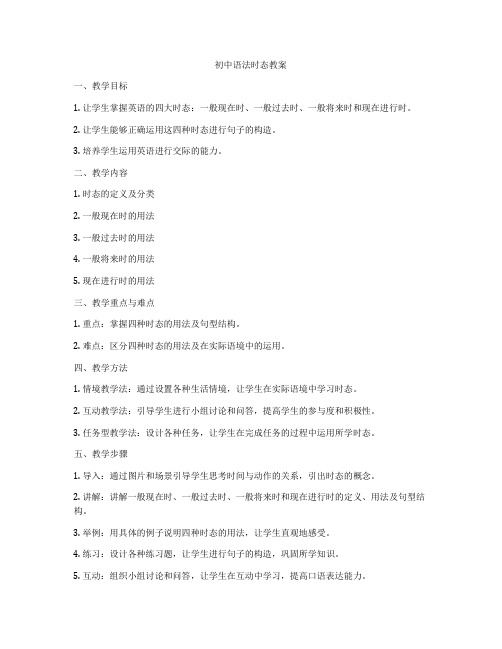
初中语法时态教案一、教学目标1. 让学生掌握英语的四大时态:一般现在时、一般过去时、一般将来时和现在进行时。
2. 让学生能够正确运用这四种时态进行句子的构造。
3. 培养学生运用英语进行交际的能力。
二、教学内容1. 时态的定义及分类2. 一般现在时的用法3. 一般过去时的用法4. 一般将来时的用法5. 现在进行时的用法三、教学重点与难点1. 重点:掌握四种时态的用法及句型结构。
2. 难点:区分四种时态的用法及在实际语境中的运用。
四、教学方法1. 情境教学法:通过设置各种生活情境,让学生在实际语境中学习时态。
2. 互动教学法:引导学生进行小组讨论和问答,提高学生的参与度和积极性。
3. 任务型教学法:设计各种任务,让学生在完成任务的过程中运用所学时态。
五、教学步骤1. 导入:通过图片和场景引导学生思考时间与动作的关系,引出时态的概念。
2. 讲解:讲解一般现在时、一般过去时、一般将来时和现在进行时的定义、用法及句型结构。
3. 举例:用具体的例子说明四种时态的用法,让学生直观地感受。
4. 练习:设计各种练习题,让学生进行句子的构造,巩固所学知识。
5. 互动:组织小组讨论和问答,让学生在互动中学习,提高口语表达能力。
6. 任务:设计实际任务,让学生在完成任务的过程中运用所学时态。
7. 总结:对本节课的内容进行总结,强调重点和难点。
8. 作业:布置作业,让学生巩固所学知识。
六、教学评价1. 课堂参与度:观察学生在课堂上的积极参与程度,包括发言、讨论等。
2. 练习正确率:检查学生练习题的正确率,了解学生对知识的掌握程度。
3. 任务完成情况:评价学生在完成任务过程中的表现,包括语言运用能力、合作精神等。
4. 作业完成情况:检查学生作业的完成质量,了解学生对知识的巩固程度。
通过以上教学设计,相信学生能够较好地掌握英语的四大时态,并在实际语境中灵活运用。
初中英语时态语态教案终极版

初中英语时态语态教案终极整理版第一章:引言1.1 目的:让学生了解英语时态和语态的基本概念和重要性。
1.2 教学内容:时态和语态的定义时态和语态的分类时态和语态在句子中的作用1.3 教学方法:讲授法:讲解时态和语态的定义及分类互动法:让学生举例说明时态和语态在句子中的作用第二章:一般现在时2.1 目的:让学生掌握一般现在时的构成和用法。
2.2 教学内容:一般现在时的构成:主语+动词原形一般现在时的用法:描述习惯性动作、普遍真理、客观事实2.3 教学方法:讲授法:讲解一般现在时的构成和用法练习法:让学生进行一般现在时的句子练习第三章:一般过去时3.1 目的:让学生掌握一般过去时的构成和用法。
3.2 教学内容:一般过去时的构成:主语+动词过去式一般过去时的用法:描述过去发生的动作或状态3.3 教学方法:讲授法:讲解一般过去时的构成和用法练习法:让学生进行一般过去时的句子练习第四章:一般将来时4.1 目的:让学生掌握一般将来时的构成和用法。
4.2 教学内容:一般将来时的构成:主语+will+动词原形一般将来时的用法:描述将来发生的动作或计划4.3 教学方法:讲授法:讲解一般将来时的构成和用法练习法:让学生进行一般将来时的句子练习第五章:现在进行时5.1 目的:让学生掌握现在进行时的构成和用法。
5.2 教学内容:现在进行时的构成:主语+am/is/are+动词ing 现在进行时的用法:描述正在进行的动作或状态5.3 教学方法:讲授法:讲解现在进行时的构成和用法练习法:让学生进行现在进行时的句子练习第六章:现在完成时6.1 目的:让学生掌握现在完成时的构成和用法。
6.2 教学内容:现在完成时的构成:主语+have/has+过去分词现在完成时的用法:描述过去发生的动作对现在造成的影响或结果6.3 教学方法:讲授法:讲解现在完成时的构成和用法练习法:让学生进行现在完成时的句子练习第七章:过去进行时7.1 目的:让学生掌握过去进行时的构成和用法。
初中语法时态总结教案

初中语法时态总结教案教学目标:1. 理解英语中常见的八种时态及其用法。
2. 能够正确运用各种时态描述动作或状态的发生时间。
3. 提高学生对英语时态的运用能力,增强语法知识储备。
教学重点:1. 掌握一般现在时、一般过去时、一般将来时、过去将来时、现在进行时、过去进行时、现在完成时、过去完成时的结构及用法。
2. 能够根据语境选择合适的时态。
教学难点:1. 各种时态之间的区别和联系。
2. 正确运用时态描述复杂的时间状语。
教学准备:1. PPT展示各种时态的例子。
2. 练习题。
教学过程:Step 1:导入(5分钟)1. 引导学生回顾之前学过的时态知识,如一般现在时、一般过去时等。
2. 提问:同学们认为英语中时态的重要性如何?Step 2:讲解时态(20分钟)1. 利用PPT展示各种时态的结构和用法,如一般现在时、一般过去时、一般将来时等。
2. 通过例句解释每种时态的含义和用法。
3. 引导学生分析各种时态之间的区别和联系。
Step 3:练习(15分钟)1. 分组进行练习,要求学生用不同的时态描述给出的情境。
2. 教师选取部分学生的答案进行讲解和分析。
Step 4:课堂小结(5分钟)1. 教师总结本节课所学内容,强调各种时态的用法和重要性。
2. 提醒学生要注意时态的正确运用。
Step 5:课后作业(10分钟)1. 要求学生完成课后练习题,巩固所学时态知识。
2. 鼓励学生多进行时态练习,提高运用能力。
教学反思:本节课通过讲解和练习,使学生对英语中常见的八种时态有了更深入的了解。
在教学过程中,要注意引导学生分析各种时态之间的区别和联系,提高他们的语法素养。
同时,通过课后作业的布置,让学生巩固所学知识,提高运用能力。
总之,本节课旨在帮助学生掌握英语时态知识,提高他们的语法水平。
初中英语九年级动词时态专题复习教案(共5则范文)

初中英语九年级动词时态专题复习教案(共5则范文)第一篇:初中英语九年级动词时态专题复习教案(共)The Teaching Plan for Review of Tenses(1)任教学校:民勤县夹河中学授课教师:张玲授课年级:九年级授课时间:2016年4月25日Ⅰ.Teaching Aims and Demands:1.To revise the eight types of tenses that we've learned.2.Moral object: Practice makes perfect.Ⅱ.Teaching Key Points and Difficulties:1.The usages and forms of the tenses.pare different tensesⅢ.Teaching Aids:Multimedia and some cards.Ⅳ.T eaching Procedures:Step1.Greet the class.Step2.Lead-in.In this class, we'll review the eight types of tenses.Just now, we heard the song that is my favorite.Because it told us a love story that I was very impressed.In fact, many people and things have been touching us in the daily life.Today, I’d like you to follow me to feel these real moving stories.Please read these stories in your group, then finish these tasks ,Step3.Revise the usages of the tenses.Let student read three stories in materials in groups and then let them complete the tasks it given.Step4.Chant.Show the forms of each kind of tenses on the screen, play the music and chant with the whole class.Have them remember the forms.Chant Do does am is are Did was were Am/is /are doing Was/were doingWill/shall do and be going to Should/would do Have/has done And had done Step5.Practice.T ake the word work as an example, practice using the different forms of this word to fill in the blanks.1.He often works on the farm.2.He worked on the farm2 years ago.3.He is working on the farm now.4.He was working on the farm those years.5.He will work on the farm next year.6.He said he would work on the farm the next month.7.He has worked on the farm for three years.8.He said he had worked on the farm for 5 years.Step6.Do some exercises.Step7.Summary.In this class, we've revised the eight types of tenses about their usages and forms.We've also do some practice about them.But it is not enough, you should do more practice.Because practice makes perfect.Study hard and try your best.I believe you will make a great success in the Entrance Examination this year.Best wishes for you!Step8.Homework.At last I'll leave some homework for you.Write an article about yourself, tell us your past, your present and your future.第二篇:浅谈初中英语动词时态教学浅谈初中英语动词时态教学英语的动词时态这一语法现象与我们母语的语法差别较大,学起来也较乏味。
最新初中英语时态教案终极整理版

最新初中英语时态教案终极整理版In middle school English。
students typically learn and are tested on eight tenses out of the total sixteen tenses in the language。
These eight tenses include the present simple。
past simple。
future simple。
present continuous。
past continuous。
present perfect。
future perfect。
and past perfect.The present simple tense is used to XXX ns。
states。
characteristics。
XXX in the present。
Common time ns used with this tense include "often," "usually," "sometimes," "always," "every day," "never," "in the morning," "every week/day," etc。
For example。
"I get up at six every morning" (habitual n)。
"He plays tennis once a week" (ongoing n)。
"The sun rises in the east" (objective truth)。
"XXX English in a school" (present state).This XXX to express future events。
初中复习课英语时态教案

初中复习课英语时态教案1. 知识与技能:(1)掌握四种基本时态(一般现在时、一般过去时、一般将来时、现在进行时)的构成和用法;(2)能够区分这四种时态,并在实际语境中运用;(3)了解时态的呼应原则,能在句子中正确运用相应的时态。
2. 过程与方法:(1)通过实例讲解,让学生理解时态的概念和意义;(2)通过小组讨论和练习,培养学生运用时态的能力;(3)运用多媒体手段,提高学生的学习兴趣和参与度。
3. 情感态度与价值观:(1)培养学生对英语时态学习的兴趣;(2)培养学生积极思考、主动探究的学习精神;(3)培养学生合作学习的能力,提高团队意识。
二、教学内容1. 教学重点:四种基本时态的构成和用法。
2. 教学难点:时态的区分和应用,特别是在实际语境中的运用。
三、教学过程1. 导入:(1)教师通过提问方式引导学生回顾已学过的时态知识;(2)学生分享对时态的理解和认识。
2. 讲解:(1)教师通过实例讲解四种基本时态的构成和用法;(2)学生跟随教师一起总结时态的规律;(3)教师强调时态的呼应原则,让学生明白在句子中如何正确运用相应的时态。
3. 练习:(1)学生分组进行练习,运用所学时态编写句子;(2)教师选取部分学生的练习进行点评和指导;(3)学生根据教师的反馈,修改自己的练习。
4. 拓展:(1)教师引导学生思考时态在实际生活中的应用;(2)学生分享自己的感悟和体验;(3)教师总结时态在生活中的重要性。
5. 总结:(1)教师带领学生回顾本节课所学内容;(2)学生自主总结时态的知识点;(3)教师布置作业,巩固所学知识。
四、教学评价1. 课堂参与度:观察学生在课堂上的发言和互动情况,评价学生的参与度;2. 练习完成情况:检查学生完成的练习,评价学生的学习效果;3. 课后作业:批改学生的课后作业,评价学生对课堂所学知识的掌握程度。
五、教学反思教师在课后要对课堂教学进行反思,分析教学过程中的优点和不足,针对性地调整教学策略,以提高教学效果。
初中时态语态整合教案

初中时态语态整合教案一、教学目标1. 让学生掌握一般现在时、一般过去时、一般将来时、现在进行时、现在完成时、过去完成时、过去进行时、过去将来时的概念和用法。
2. 培养学生正确运用各种时态和语态表达真实情景的能力。
3. 提高学生英语语法综合运用能力,为初中英语学习打下坚实基础。
二、教学内容1. 一般现在时:概念、时间状语、基本结构、否定形式、一般疑问句。
2. 一般过去时:概念、时间状语、基本结构、否定形式、一般疑问句。
3. 一般将来时:概念、时间状语、基本结构、否定形式、一般疑问句。
4. 现在进行时:概念、时间状语、基本结构、否定形式、一般疑问句。
5. 现在完成时:概念、时间状语、基本结构、否定形式、一般疑问句。
6. 过去完成时:概念、时间状语、基本结构、否定形式、一般疑问句。
7. 过去进行时:概念、时间状语、基本结构、否定形式、一般疑问句。
8. 过去将来时:概念、时间状语、基本结构、否定形式、一般疑问句。
三、教学过程1. 导入:通过日常生活中的实例,引导学生思考时态与语态在表达中的重要性。
2. 新课呈现:讲解各种时态与语态的概念、用法和结构。
3. 实例分析:通过具体例句,让学生区分各种时态与语态的差别。
4. 练习巩固:设计相关练习题,让学生运用所学时态与语态进行句子仿写和对话练习。
5. 总结提升:对本节课的内容进行总结,强调重点和难点。
6. 课后作业:布置相关作业,让学生进一步巩固所学知识。
四、教学策略1. 采用直观、生动的教学手段,如图片、动画、视频等,激发学生的学习兴趣。
2. 通过实例分析,让学生在实际语境中感受时态与语态的应用。
3. 设计丰富的练习题,注重分层教学,使每位学生都能得到有效的训练。
4. 组织小组讨论和互动,鼓励学生主动参与课堂,提高课堂活力。
5. 注重个体差异,给予学生充分的关注和指导,帮助其克服学习困难。
五、教学评价1. 课堂表现:观察学生在课堂上的参与程度、发言情况等。
2. 练习完成情况:检查学生作业、测验等的完成质量。
初中英语时态教案完整版
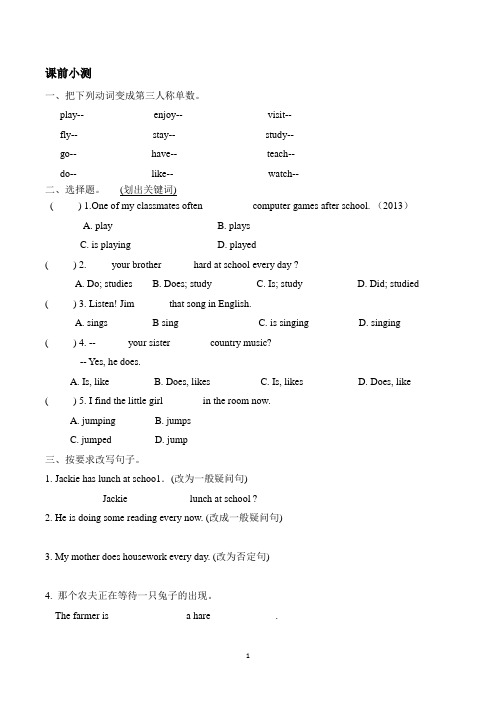
课前小测一、把下列动词变成第三人称单数。
play--_________ enjoy--__________ visit--_________fly--________ stay--________ study--_________go--________ have--________ teach--_________do--________ like--________ watch--__________二、选择题。
(划出关键词)( ) 1.One of my classmates often _________ computer games after school. (2013)A. playB. playsC. is playingD. played( ) 2. ____ your brother ______hard at school every day ?A. Do; studiesB. Does; studyC. Is; studyD. Did; studied ( ) 3. Listen! Jim ______ that song in English.A. sings B sing C. is singing D. singing ( ) 4. --______ your sister _______ country music?-- Yes, he does.A. Is, likeB. Does, likesC. Is, likesD. Does, like ( ) 5. I find the little girl _______ in the room now.A. jumpingB. jumpsC. jumpedD. jump三、按要求改写句子。
1. Jackie has lunch at schoo1.(改为一般疑问句)_________ Jackie __________ lunch at school ?2. He is doing some reading every now. (改成一般疑问句)_____________________________________________3. My mother does housework every day. (改为否定句)_____________________________________________4. 那个农夫正在等待一只兔子的出现。
初中英语时态和语态复习教案

初中英语时态和语态复习教案一、教学目标1. 熟练掌握英语的基本时态和语态;2. 能正确运用各种时态和语态进行句子转换;3. 加深对时态和语态的理解,提高英语语言运用能力。
二、教学内容时态和语态的复习和运用三、教学过程1. 导入通过展示一张图片或播放一个视频,引导学生回忆过去发生的事情,并让学生使用过去时描述图片或视频内容。
2. 时态的复习(1)现在时态- 用法:表示现在正在进行的动作或状态。
- 结构:主语 + 动词-ing- 例句:I am studying English now.(2)过去时态- 用法:表示过去发生的动作或状态。
- 结构:主语 + 动词过去式- 例句:He went to the park yesterday.(3)将来时态- 用法:表示将来要发生的动作或状态。
- 结构:主语 + will + 动词原形- 例句:They will have a meeting tomorrow.3. 时态转换练习让学生根据给出的句子,将其改写成其他时态,并解释改变的原因和规则。
例题:(1) They are playing basketball now.转换为过去时态:They were playing basketball yesterday.解释:由于动作是在过去发生的,所以需要将现在时态改为过去时态。
(2) I will go to the supermarket tomorrow.转换为现在进行时:I am going to the supermarket now.解释:虽然动作发生在将来,但是现在正在进行。
4. 语态的复习(1)被动语态- 用法:强调动作的承受者而非执行者。
- 结构:主语 + be + 过去分词(动词-ed)- 例句:The book was written by him.(2)进行时的被动语态- 用法:强调正在进行的被动动作。
- 结构:主语 + be + being + 过去分词(动词-ed)- 例句:The car is being repaired by the mechanic.(3)完成时的被动语态- 用法:强调动作已经完成的被动语态。
初中英语时态教案
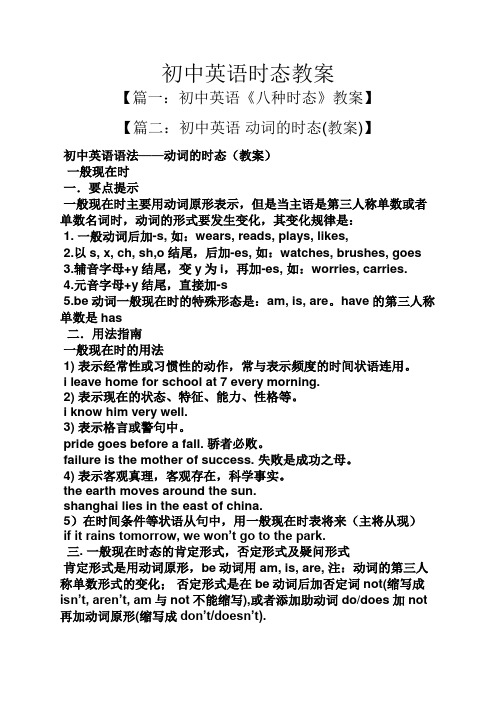
初中英语时态教案【篇一:初中英语《八种时态》教案】【篇二:初中英语动词的时态(教案)】初中英语语法——动词的时态(教案)一般现在时一.要点提示一般现在时主要用动词原形表示,但是当主语是第三人称单数或者单数名词时,动词的形式要发生变化,其变化规律是:1. 一般动词后加-s, 如:wears, reads, plays, likes,2.以s, x, ch, sh,o结尾,后加-es, 如:watches, brushes, goes3.辅音字母+y结尾,变y为i,再加-es, 如:worries, carries.4.元音字母+y结尾,直接加-s5.be动词一般现在时的特殊形态是:am, is, are。
have的第三人称单数是has二.用法指南一般现在时的用法1) 表示经常性或习惯性的动作,常与表示频度的时间状语连用。
i leave home for school at 7 every morning.2) 表示现在的状态、特征、能力、性格等。
i know him very well.3) 表示格言或警句中。
pride goes before a fall. 骄者必败。
failure is the mother of success. 失败是成功之母。
4) 表示客观真理,客观存在,科学事实。
the earth moves around the sun.shanghai lies in the east of china.5)在时间条件等状语从句中,用一般现在时表将来(主将从现)if it rains tomorrow, we won’t go to the park.三. 一般现在时态的肯定形式,否定形式及疑问形式肯定形式是用动词原形,be动词用am, is, are, 注:动词的第三人称单数形式的变化;否定形式是在be动词后加否定词not(缩写成isn’t, aren’t, am与not不能缩写),或者添加助动词do/does加not 再加动词原形(缩写成don’t/doesn’t).疑问形式是把be动词或助动词do/does提置句首, 动词还原,句末问号,人称上第一人称变第二人称,第二人称变第一人称或不变,第三人称不变。
初中时态英语教案

初中时态英语教案一、教学目标1. 让学生掌握一般现在时、一般过去时和一般将来时这三种基本时态的构成和用法。
2. 培养学生运用英语时态进行交际的能力。
3. 提高学生对英语时态的认识,使他们在日常生活中能够正确运用英语表达时间概念。
二、教学内容1. 一般现在时:表示经常性、习惯性的动作或状态。
2. 一般过去时:表示过去发生的动作或状态。
3. 一般将来时:表示将来要发生的动作或状态。
三、教学重点与难点1. 重点:一般现在时、一般过去时和一般将来时的构成和用法。
2. 难点:一般将来时的运用和时态的转换。
四、教学方法1. 情境教学法:通过设置各种情境,让学生在实际语境中感受和运用时态。
2. 任务型教学法:通过完成各种任务,培养学生运用时态进行交际的能力。
3. 互动式教学法:引导学生参与课堂互动,提高他们的学习积极性。
五、教学步骤Step 1: 引入话题1. 教师出示各种图片,如:正在读书的学生、过去的毕业照片、未来的旅游计划等。
2. 引导学生用中文描述这些图片所表示的时间概念。
Step 2: 讲解时态1. 教师简要讲解一般现在时、一般过去时和一般将来时的构成和用法。
2. 举例说明各种时态的运用场合。
Step 3: 实践练习1. 学生分组进行角色扮演,运用所学的时态进行对话。
2. 教师选取部分学生进行展示,并给予评价。
Step 4: 任务完成1. 学生分组完成各种任务,如:编写小故事、制作时间轴等。
2. 教师选取部分任务进行展示,并给予评价。
Step 5: 总结与拓展1. 教师引导学生总结本节课所学的时态及其运用场合。
2. 学生举例说明在日常生活中如何正确运用这些时态。
3. 教师给出一些拓展练习,让学生课后巩固所学知识。
六、教学反思本节课通过情境教学、任务型教学和互动式教学等方法,让学生在实际语境中感受和运用一般现在时、一般过去时和一般将来时。
在实践练习和任务完成环节,学生能够积极参与,运用所学时态进行交际。
初中时态语态教案

初中时态语态教案一、教学目标1. 让学生掌握英语中的基本时态和语态,包括一般现在时、一般过去时、一般将来时、现在进行时、现在完成时、现在完成进行时、过去进行时、过去完成时、过去完成进行时。
2. 培养学生能够正确运用这些时态和语态表达过去、现在和将来的动作或状态。
3. 提高学生对英语时态和语态在实际语境中的运用能力。
二、教学内容1. 时态:一般现在时、一般过去时、一般将来时、现在进行时、现在完成时、现在完成进行时、过去进行时、过去完成时、过去完成进行时。
2. 语态:主动语态和被动语态。
三、教学方法1. 采用任务型教学法,通过小组合作、讨论等形式,让学生在实际语境中运用所学时态和语态。
2. 运用多媒体教学手段,如课件、视频等,直观地展示时态和语态的用法。
3. 采用互动式教学法,教师与学生充分交流,引导学生主动探究、发现和总结时态和语态的规律。
四、教学步骤1. 导入:通过一个发生在学校的故事,引出一般现在时、一般过去时和一般将来时的概念。
2. 新课:讲解一般现在时、一般过去时和一般将来时的用法,并通过例句和练习让学生熟练掌握。
3. 语态:讲解主动语态和被动语态的概念及用法,并通过例句和练习让学生掌握。
4. 实践:让学生分组讨论,运用所学时态和语态编写小故事,并进行展示。
5. 总结:教师引导学生总结本节课所学内容,强化记忆。
6. 作业:布置相关练习题,巩固所学知识。
五、教学评价1. 课堂参与度:观察学生在课堂上的发言和互动情况,评价学生的参与度。
2. 作业完成情况:检查学生作业的完成质量,评价学生对所学知识的掌握程度。
3. 小组讨论:评价学生在小组讨论中的表现,包括合作意识、创新能力和语言运用能力。
六、教学反思在课后,教师应认真反思本节课的教学效果,针对学生的实际情况,调整教学策略,以提高学生对英语时态和语态的掌握程度。
同时,关注学生的个体差异,给予不同程度的学生更多的关注和指导,确保教学质量。
(word完整版)初中英语时态语态教案终极整理版
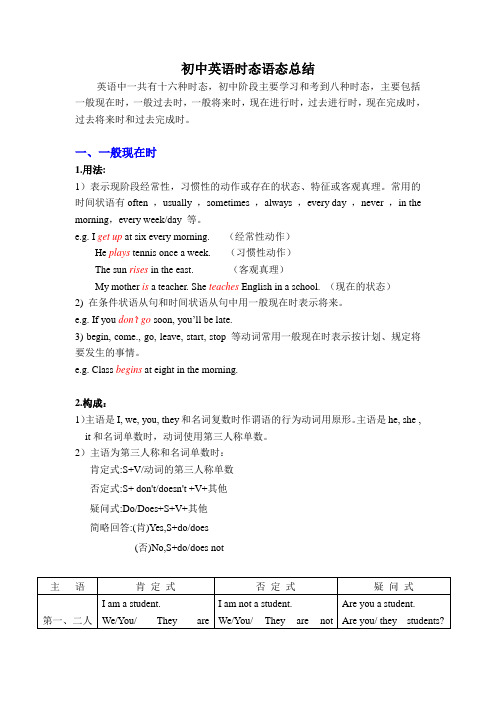
初中英语时态语态总结英语中一共有十六种时态,初中阶段主要学习和考到八种时态,主要包括一般现在时,一般过去时,一般将来时,现在进行时,过去进行时,现在完成时,过去将来时和过去完成时。
一、一般现在时1.用法:1)表示现阶段经常性,习惯性的动作或存在的状态、特征或客观真理。
常用的时间状语有often ,usually ,sometimes ,always ,every day ,never ,in the morning,every week/day 等。
e.g. I get up at six every morning. (经常性动作)He plays tennis once a week. (习惯性动作)The sun rises in the east. (客观真理)My mother is a teacher. She teaches English in a school. (现在的状态)2) 在条件状语从句和时间状语从句中用一般现在时表示将来。
e.g. If you don’t go soon, you’ll be late.3) begin, come., go, leave, start, stop 等动词常用一般现在时表示按计划、规定将要发生的事情。
e.g. Class begins at eight in the morning.2.构成:1)主语是I, we, you, they和名词复数时作谓语的行为动词用原形。
主语是he, she , it和名词单数时,动词使用第三人称单数。
2)主语为第三人称和名词单数时:肯定式:S+V/动词的第三人称单数否定式:S+ don't/doesn't +V+其他疑问式:Do/Does+S+V+其他简略回答:(肯)Yes,S+do/does(否)No,S+do/does not3)当主语是第一、二人称和第三人称复数以及名词复数时:肯定式: S + be +···否定式: S+ be +not + ···疑问式: Am /Is /Are + S+ ···?简略回答: (肯) Yes,S + be.(否) No,S + be.真题:1.——Can your father drive? (08 武汉)——Yes, and he usually to school.A droveB is drivingC drivesD has driven2.If I find his phone number, I you. (09 北京)A tellB toldC will tellD have told3. The teacher told the students that the earth round, not flat. (08 天津)A isB wasC has beenD is being二、一般过去时1. 表示过去某段时间发生的事,存在的状态或过去反复发生的动作时用一般过去时。
初中时态语态教案详细
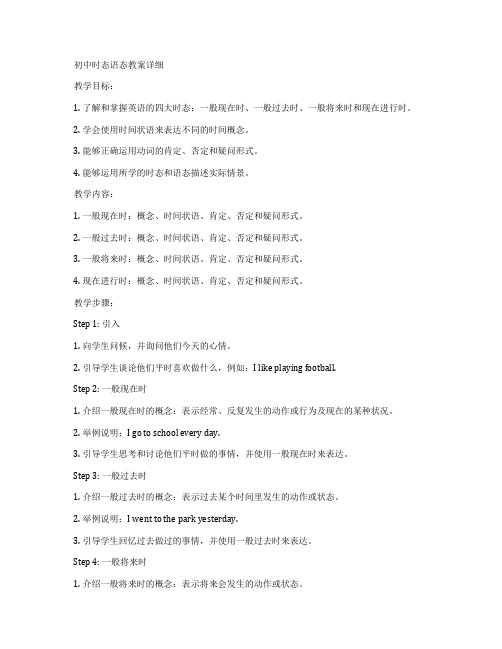
初中时态语态教案详细教学目标:1. 了解和掌握英语的四大时态:一般现在时、一般过去时、一般将来时和现在进行时。
2. 学会使用时间状语来表达不同的时间概念。
3. 能够正确运用动词的肯定、否定和疑问形式。
4. 能够运用所学的时态和语态描述实际情景。
教学内容:1. 一般现在时:概念、时间状语、肯定、否定和疑问形式。
2. 一般过去时:概念、时间状语、肯定、否定和疑问形式。
3. 一般将来时:概念、时间状语、肯定、否定和疑问形式。
4. 现在进行时:概念、时间状语、肯定、否定和疑问形式。
教学步骤:Step 1: 引入1. 向学生问候,并询问他们今天的心情。
2. 引导学生谈论他们平时喜欢做什么,例如:I like playing football.Step 2: 一般现在时1. 介绍一般现在时的概念:表示经常、反复发生的动作或行为及现在的某种状况。
2. 举例说明:I go to school every day.3. 引导学生思考和讨论他们平时做的事情,并使用一般现在时来表达。
Step 3: 一般过去时1. 介绍一般过去时的概念:表示过去某个时间里发生的动作或状态。
2. 举例说明:I went to the park yesterday.3. 引导学生回忆过去做过的事情,并使用一般过去时来表达。
Step 4: 一般将来时1. 介绍一般将来时的概念:表示将来会发生的动作或状态。
2. 举例说明:I will go to the zoo tomorrow.3. 引导学生思考将来的计划或打算,并使用一般将来时来表达。
Step 5: 现在进行时1. 介绍现在进行时的概念:表示现阶段或说话时正在进行的动作及行为。
2. 举例说明:I am reading a book now.3. 引导学生观察和描述正在进行的动作或行为。
Step 6: 练习与巩固1. 提供一些句子,让学生选择合适的时态来完成。
2. 让学生分组,相互练习使用所学的时态来描述自己的经历和计划。
初中英语时态教案终极整理版
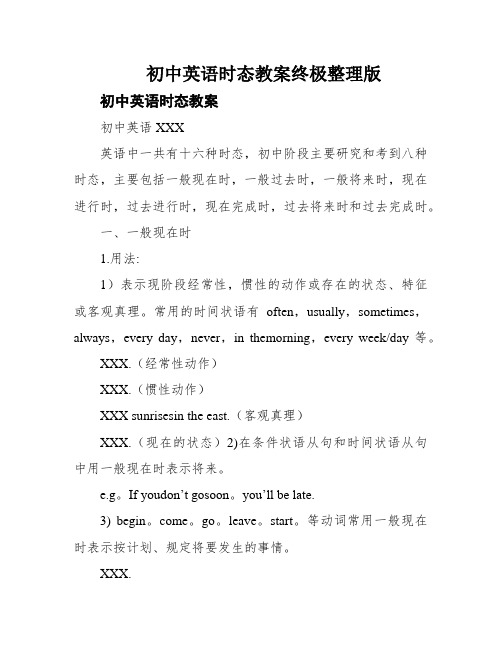
初中英语时态教案终极整理版初中英语时态教案初中英语XXX英语中一共有十六种时态,初中阶段主要研究和考到八种时态,主要包括一般现在时,一般过去时,一般将来时,现在进行时,过去进行时,现在完成时,过去将来时和过去完成时。
一、一般现在时1.用法:1)表示现阶段经常性,惯性的动作或存在的状态、特征或客观真理。
常用的时间状语有often,usually,sometimes,always,every day,never,in themorning,every week/day等。
XXX.(经常性动作)XXX.(惯性动作)XXX sunrisesin the east.(客观真理)XXX.(现在的状态)2)在条件状语从句和时间状语从句中用一般现在时表示将来。
e.g。
If youdon’t gosoon。
you’ll be late.3) begin。
come。
go。
leave。
start。
等动词常用一般现在时表示按计划、规定将要发生的事情。
XXX.2.组成:1)主语是I。
we。
you。
they和名词复数时作谓语的行动动词用真相。
主语是he。
she。
it和名词单数时,动词利用第三人称单数。
2)主语为第三人称和名词单数时:一定式:S+V/动词的第三人称单数否定式:XXX其他疑问式:Do/Does+S+V+其他简略回答:(肯)Yes,S+do/does否)No,S+do/does not主语一定式I am a student.否认式I am not a student.疑问式Are you a student.第一、二人We/You/称和第三人students.XXX?students.He/ She is not a student.Is he/ she a student?XXX称复数以及He/ She is a student.名词复数music.Many people like music.I / We/ You/ They/ don’t likeDo you/ they like music?XXX?music.I/XXX.3)当主语是第一、二人称和第三人称复数以及名词复数时:一定式:S + be +···否定式:S+ be +not + ···疑问式:Am /Is /Are + S+ ···?简略回答: (肯) Yes,S + be.否) No,S + be.真题:1.——Can your father drive?(08武汉)Yes。
英语时态初中教案
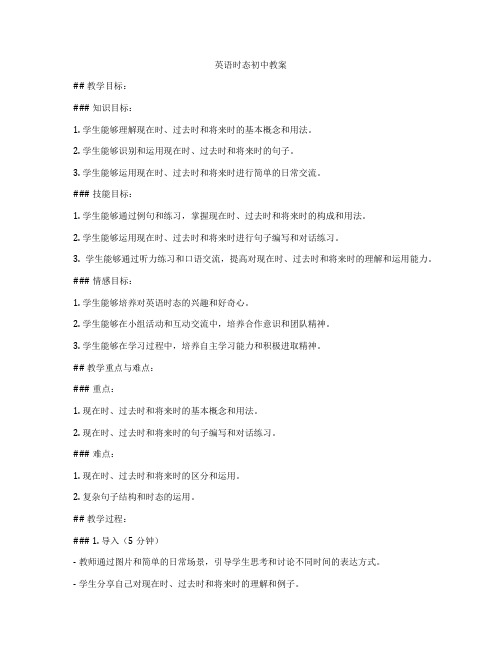
英语时态初中教案## 教学目标:### 知识目标:1. 学生能够理解现在时、过去时和将来时的基本概念和用法。
2. 学生能够识别和运用现在时、过去时和将来时的句子。
3. 学生能够运用现在时、过去时和将来时进行简单的日常交流。
### 技能目标:1. 学生能够通过例句和练习,掌握现在时、过去时和将来时的构成和用法。
2. 学生能够运用现在时、过去时和将来时进行句子编写和对话练习。
3. 学生能够通过听力练习和口语交流,提高对现在时、过去时和将来时的理解和运用能力。
### 情感目标:1. 学生能够培养对英语时态的兴趣和好奇心。
2. 学生能够在小组活动和互动交流中,培养合作意识和团队精神。
3. 学生能够在学习过程中,培养自主学习能力和积极进取精神。
## 教学重点与难点:### 重点:1. 现在时、过去时和将来时的基本概念和用法。
2. 现在时、过去时和将来时的句子编写和对话练习。
### 难点:1. 现在时、过去时和将来时的区分和运用。
2. 复杂句子结构和时态的运用。
## 教学过程:### 1. 导入(5分钟)- 教师通过图片和简单的日常场景,引导学生思考和讨论不同时间的表达方式。
- 学生分享自己对现在时、过去时和将来时的理解和例子。
### 2. 讲解(15分钟)- 教师通过PPT或黑板,讲解现在时、过去时和将来时的构成和用法。
- 教师举例说明不同时态的句子结构和常见用法。
### 3. 练习(15分钟)- 学生分组进行练习,编写不同时态的句子。
- 学生互相交换句子,并进行纠正和讨论。
### 4. 听力练习(10分钟)- 教师播放听力材料,包含现在时、过去时和将来时的句子。
- 学生听后,回答相关问题,并进行口语交流。
### 5. 小组活动(10分钟)- 学生分成小组,进行角色扮演或小组讨论。
- 学生运用现在时、过去时和将来时,进行对话练习。
### 6. 总结与作业(5分钟)- 教师对本节课的内容进行总结,强调重点和难点。
- 1、下载文档前请自行甄别文档内容的完整性,平台不提供额外的编辑、内容补充、找答案等附加服务。
- 2、"仅部分预览"的文档,不可在线预览部分如存在完整性等问题,可反馈申请退款(可完整预览的文档不适用该条件!)。
- 3、如文档侵犯您的权益,请联系客服反馈,我们会尽快为您处理(人工客服工作时间:9:00-18:30)。
初中英语时态教案初中英语李怡梦英语中一共有十六种时态,初中阶段主要学习和考到八种时态,主要包括一般现在时,一般过去时,一般将来时,现在进行时,过去进行时,现在完成时,过去将来时和过去完成时。
一、一般现在时1.用法:1)表示现阶段经常性,习惯性的动作或存在的状态、特征或客观真理。
常用的时间状语有often ,usually ,sometimes ,always ,every day ,never ,in the morning,every week/day 等。
e.g. I get up at six every morning. (经常性动作)He plays tennis once a week. (习惯性动作)The sun rises in the east. (客观真理)My mother is a teacher. She teaches English in a school. (现在的状态)2) 在条件状语从句和时间状语从句中用一般现在时表示将来。
e.g. If you don’t go soon, you’ll be late.3) begin, come., go, leave, start, stop 等动词常用一般现在时表示按计划、规定将要发生的事情。
e.g. Class begins at eight in the morning.2.构成:1)主语是I, we, you, they和名词复数时作谓语的行为动词用原形。
主语是he, she , it和名词单数时,动词使用第三人称单数。
2)主语为第三人称和名词单数时:肯定式:S+V/动词的第三人称单数否定式:S+ don't/doesn't +V+其他疑问式:Do/Does+S+V+其他简略回答:(肯)Yes,S+do/does(否)No,S+do/does not3)当主语是第一、二人称和第三人称复数以及名词复数时:肯定式: S + be +···否定式: S+ be +not + ···疑问式: Am /Is /Are + S+ ···?简略回答: (肯) Yes,S + be.(否) No,S + be.真题:1.——Can your father drive? (08 武汉)——Yes, and he usually to school.A droveB is drivingC drivesD has driven2.If I find his phone number, I you. (09 北京)A tellB toldC will tellD have told3. The teacher told the students that the earth round, not flat. (08 天津)A isB wasC has beenD is being二、一般过去时1. 表示过去某段时间发生的事,存在的状态或过去反复发生的动作时用一般过去时。
常用于一般过去时的时间状语:yesterday,three months ago,last year,in 1979等。
2. 用法:1)过去发生的动作。
e.g. The police stopped me on my way home last night.2)过去存在的状态。
e.g. They weren't able to come because they were so busy.3)be used to doing 表示过去常常做某事。
也是一般过去时的标记。
e.g. She was used to feeding the cats in the yard.3. 构成:S+V-ed1)用动词的过去式。
作谓语的行为动词的词尾变化如下:2)一般过去时态的肯定句、否定句和疑问句形式(以be和like为例):真题:1. Yesterday,Tony’s family a good time. (08 泸州)A hasB haveC had2. We were in Qingdao last week and great fun there. (08 北京)A will haveB have hadC hadD have3. My grandmother us stories when I was young. ( 09 锦州)A was used to tellB is used to tellingC are used to tellD was used to telling三、一般将来时1.用法:表示将来某个时间要发生的动作或存在的状态,常用于一般将来时的时间状语:tomorrow,next week,in 2008等。
1)将要发生的动作。
e.g. I will leave for Beijing tomorrow.2)将要存在的状态。
e.g. This time next year I will be in Japan. Where will you be?3)打算要做的事。
e.g. Are you going to watch the film on television tonight?4)come,go, start, move, sail 等动词常用进行时态表示按计划将要发生的事。
e.g. The whole family is going for two months.5) 在条件状语从句和时间状语从句中用一般现在时表示将来。
e.g. If you don’t go soon, you’ll be late.2.构成:1)助动词will(shall)+v2)be +going to +v3.will 和be going to 的区别:1)表示带意愿色彩的将来用will。
e.g. I will stay with you in the future.2) 询问对方是否愿意或表示客气的邀请和命令时用will。
e.g. Will you go to the park with me?Will you please open the door?3) 表示客观的将来,用will。
e.g. I will be 22 years old next year.4) be going to常用于口语中用来表示即将发生的动作或存在的状态。
e.g. We’re going to help some farmers with their work.5) 表示打算或准备要做的事用be going toe.g. She’s going to leave at 10 o’clock tomorrow.6) 根据某种迹象判断可能要发生的事用be going to。
e.g. Look at the clouds. It’s going to rain.真题:1.——Why are you in such a hurry, Mike? ( 09 福州)——There an NBA basketball game in ten minutes.A will haveB will beC is going to haveD are going to be2. In five years, I a doctor. ( 08 泸州)A will beB wasC am3. If they come, we a meeting.A haveB will haveC hadD would have四、现在进行时1. 用法:1)说话时正在进行或发生的动作(动作是在说话时正在进行)。
常用于现在进行时态的时间状语:now ,look, listen等。
e.g. She is having a bath now.2)现阶段正在进行或发生的动作(但是动作并不是必须在说话时正在进行)。
e.g. You are working hard today.Kate wants to work in Italy, so she is learning Italian.The population of the world is growing very fast.3)频度副词always, forever等词连用时,表示某种强烈的感情。
e.g. He is always trying out new ideas.4)表示按计划即将发生的动作(仅限于go, come, arrive, leave, start, fly, begin, stay 等动词)。
e.g. The party is beginning at 8:00 o’clock..5) “系动词+介词/副词”表示正在进行的动作。
e.g. He is at work.6) 表示感觉、愿望和状态的某些动词如hope, smell, hear, see等一般不用进行时态。
2. 构成:be+ v-ing2)肯定句、否定句、疑问句形式:肯定句:S+be +V-ing否定句:S+be+not + V-ing一般疑问句:Is(Are)+S+V-ing?特殊疑问:wh_+ be + S + V-ing?真题:1. Mr. Green to the manager now. You’d better call him later. ( 09 北京)A talkB is talkingC talkedD was talking2. Everything on the earth all the time.A is changingB is changedC has changedD has been changed3. Be quiet, please. The students a class now. (08 长春)A haveB hadC are havingD were having五、过去进行时1.用法:过去某一阶段或某一时刻正在进行的动作。
常用于过去进行时的时间状语有at four yesterday afternoon,then,at that time/moment 等。
e.g. This time last year I was living in Brazil.What were you doing at 10 o'clock last night?2.构成:was / were +v-ing3. 一般过去时和过去进行时的区别:1)一般过去时:强调过去某个时候曾有过某个动作(已经完成的)。
